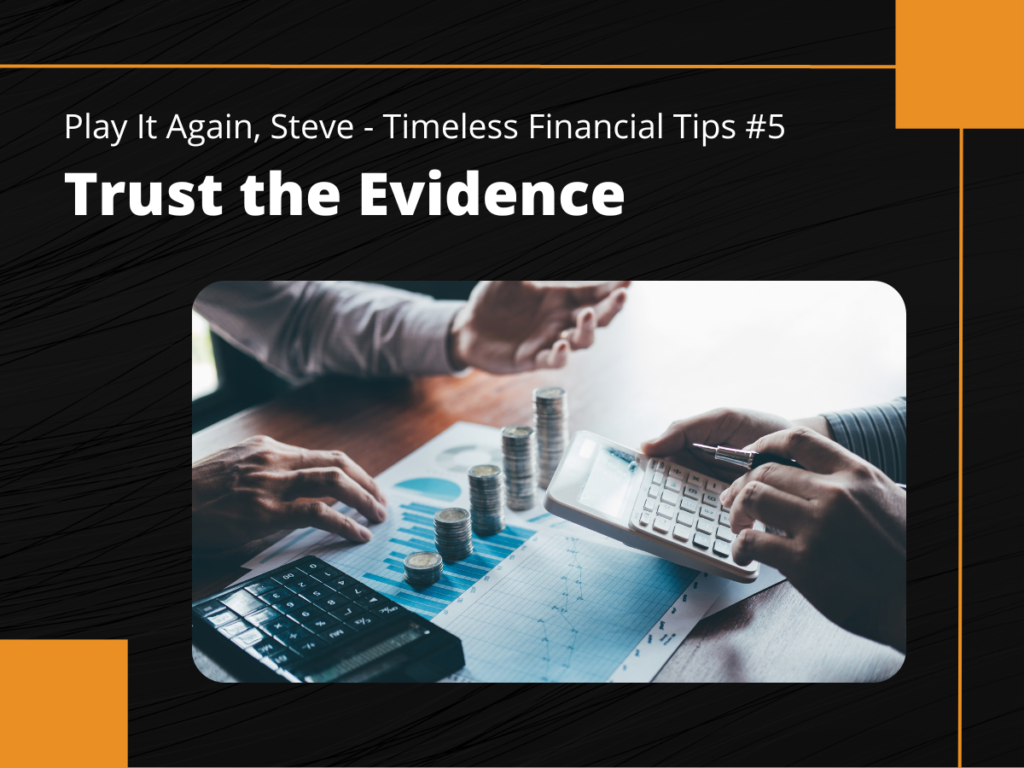<

Evidence-Based Investing – Your Best Chance to Hit Your Long-Term Investment Goals
By Steve Lowrie, CFA
Special to Financial Independence Hub
If I could, I would grant amazing investment returns to every investor across every market. Unfortunately, that’s just not how it works. In real life, we must aim toward our financial ideals, knowing we won’t hit the bullseye every time.
That’s why I recommend evidence-based investing: or investing according to our best understanding of how markets have actually delivered available returns over time, versus how we wish they would. Our “best understanding” may still be imperfect, but it sure beats ignoring reality entirely.
Luck-Based Investing and Random Returns
Many investors try to pick and choose when and how to invest based on what they or others are predicting will happen next. All evidence suggests their success or failure will be driven far more by luck than skill. Worse, going down this path, there is a very high probability they’ll end up with worse results versus a properly structured “buy and hold” approach.
Some deliberately embrace this approach, hoping to “beat” the market. Others come to it accidentally, by reacting to financial behavioural biases such as panic-selling or spree-buying. Either way, these sorts of investment portfolios typically devolve into a disheartening assortment of holdings over time, offering little sense of where you stand in relation to your own goals or overall market performance. The odds stack steeply against your achieving any carefully planned outcome: provided you had one to begin with.
Evidence-Based Investing and Portfolio Planning
In contrast, evidence-based investors adhere to decades and volumes of time-tested, peer-reviewed analysis by academics and practitioners alike. In aggregate, we seek to answer an essential investment challenge:
How can an investor increase the probability they’ll capture the highest expected market returns, given the levels of investment risk they’re willing to accept?
The answers point to a two-step strategy:
1. Build It. Prepare your personal portfolio:
- Allocate your investments between broad asset classes.
- Widely diversify your bonds and equities to reduce the unnecessary risks inherent to individual bond or stock picks.
- Tilt your overall portfolio toward factors with higher expected returns, according to your personal financial goals and risk tolerances.
2. Keep It. Sit tight with your carefully constructed portfolio for the long term, to ensure you capture the expected long-term growth from your various market allocations. So, stay invested through thick and thin and set aside enough cash reserves to cover upcoming spending needs.
At the risk of repeating ourselves (which is, after all, the theme of this “Play It Again, Steve” financial tips blog series), evidence-based investing translates into building and maintaining a portfolio that looks something like this:

Keeping It: The Hardest Thing
It’s one thing to build an ideal portfolio. It’s another to keep it in balance as intended. In fact, thanks to our behavioural biases, I would argue it’s the hardest part.
For example, what will you do after the stock market has been surging, and your 60%/40% stock/bond allocations end up being closer to 70%/ 30%.? You’ll probably want to let your overweight allocation to high-flying stocks ride, hoping to score even more. That’s because recency and other behavioural biases trick us into believing the party will never end. However, the more prudent, evidence-based move is to sell some of your equity allocations (selling high) and use the proceeds to buy more humdrum fixed income (buying low), until you’re back to your original 60%/40% mix.
Not only is selling high and buying low a smart thing to do, it ensures you’re trusting the evidence about how investment risks and rewards actually work. Remember that investment risk you were planning to avoid with your more conservative 60%/40% mix? It may not feel like it in bullish times, but the risk is still there, often waiting to resurface when you least expect it. When it does, you’ll regret it if you haven’t taken some profits off the table when you had the chance. You may even decide to try selling after the fact, although that’s only expected to add insult to the injury.
Avoiding “The Big Mistake” and Other Timeless Tips
In line with the theme of keeping what you’ve got, let’s say you mostly buy into an evidence-based investing strategy. But then, one day, markets plummet. Or your neighbor says you have to get in on some fantastic deal. Or some other seemingly one-off event tempts you to reconsider your position.
You wouldn’t be human if you didn’t sometimes question past decisions. Unfortunately, even if you only deviate from a well-crafted portfolio in an extreme event, the financial damage can last a lifetime. I’ve seen investors cave like this many times, hoping to dodge bad markets or chase hot trends. It still makes me cringe every time someone does that, because it usually ends up being an ugly choice in hindsight.
Committing to being an evidence-based investor can’t fully stop you from making a Big Mistake, but it can put a Big Speed Bump in your way. It won’t guarantee amazing returns either; nothing can. But it will help you realistically assess your odds for investment success or failure for any given strategy.
Most of all, evidence-based investing gives you back your life. Instead of wasting quality time forever second-guessing what you just did and what you should be doing next with your investments, you get to shift this time to things and activities that are important, and you enjoy doing.
Evidence-Based Investing allows you to Enjoy Life, Knowing your Investments are On-Track
Simply put, evidence-based investing gives you your best chance to hit more of your financial targets more accurately over time. And when your ultimate aim is to spend most of your time and resources on your life’s most interesting pursuits, evidence-based investing is your most likely ticket to success.
Please be in touch if you’d like to learn more about evidence-based investing strategies.
 Steve Lowrie holds the CFA designation and has 25 years of experience dealing with individual investors. Before creating Lowrie Financial in 2009, he worked at various Bay Street brokerage firms both as an advisor and in management. “I help investors ignore the Wall and Bay Street hype and hysteria, and focus on what’s best for themselves.” This blog originally appeared on his site on May 24, 2023 and is republished here with permission.
Steve Lowrie holds the CFA designation and has 25 years of experience dealing with individual investors. Before creating Lowrie Financial in 2009, he worked at various Bay Street brokerage firms both as an advisor and in management. “I help investors ignore the Wall and Bay Street hype and hysteria, and focus on what’s best for themselves.” This blog originally appeared on his site on May 24, 2023 and is republished here with permission.Share this:
- Click to share on X (Opens in new window) X
- Click to share on LinkedIn (Opens in new window) LinkedIn
- Click to share on Facebook (Opens in new window) Facebook
- Click to share on Reddit (Opens in new window) Reddit
- Click to email a link to a friend (Opens in new window) Email
- Click to print (Opens in new window) Print

